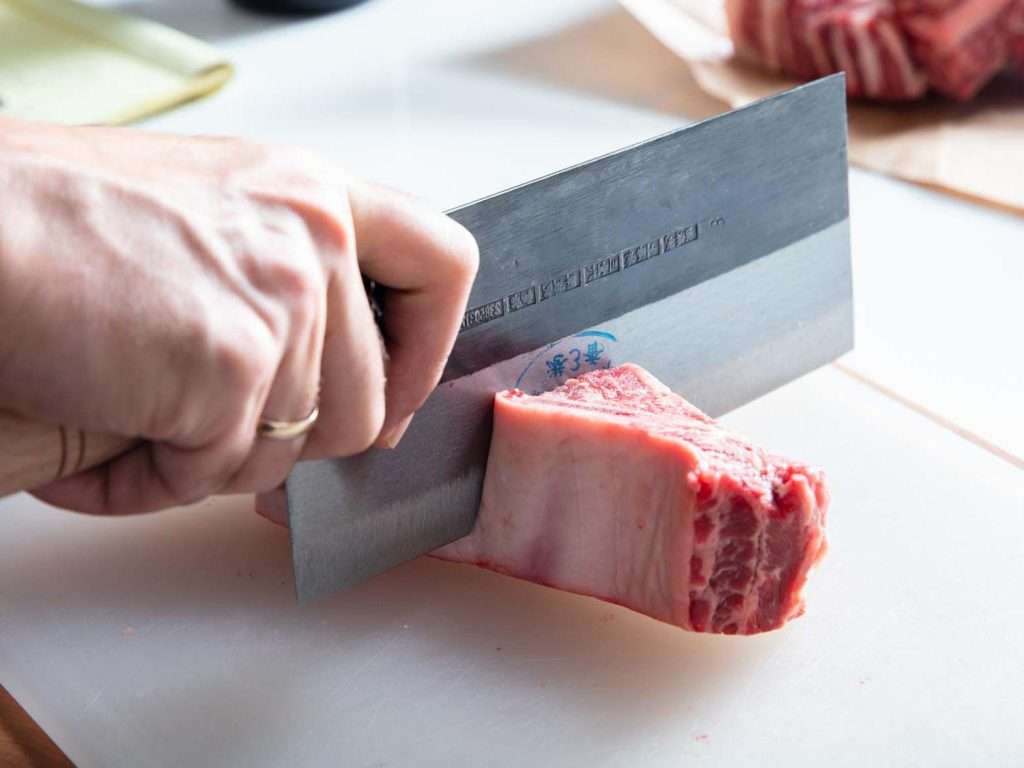Step 1: Always use a hard cutting surface.
The first step to using any cleaver is making sure you have a hard, flat cutting surface. This is important because the blade of a Chinese cleaver can be very sharp and can easily chip or break if you try cutting on soft surfaces like bread or plastic. Make sure to use an old dishwasher rack or an empty plastic container that’s been cleaned out for chopping your ingredients into smaller pieces.
The reason for this is simple: best Chinese cleavers are multipurpose tools meant to be used in a variety of ways—not just chopping up chicken bones! They can also help with slicing, dicing and crushing things like garlic cloves (or even spuds). Don’t worry if you’re not familiar with all of these techniques yet—we’ll teach them later in this series!
Step 2: Consider what to be cut with the Chinese cleaver knife.
- Consider what to be cut with the Chinese cleaver knife.
The cleaver is a knife that can be used for hard and soft foods. It’s great with both meats, vegetables and fruits as well as cutting, slicing, mincing and chopping. The best part is that it’s not limited by texture—you can use the blade to cut bones if you know what you’re doing (and have a sharp enough blade), but it won’t do much good on tough bones like chicken necks or duck feet. You’ll also find that when it comes to cutting hard vegetables like carrots or squash, this knife does an excellent job—but don’t push your luck too far: softer veggies like cucumber tend to be more difficult for a Chinese cleaver to tackle due to their delicate structure!
Step 3: Use both hands to safely hold the food and learn how to protect them.
When you hold the food, use your thumb and forefinger of your left hand to hold it. The first joint of your index finger should be used to guide the cut. In this way, you can easily protect yourself from being cut by the blade’s spine.
Step 4: Try using a rocking technique, rather than pressing.
Try using a rocking technique, rather than pressing.
- Hold the knife in your dominant hand with your forefinger and thumb on either side of the blade, at about half an inch from the tip.
- Keep your knuckles facing away from you as you hold it at an angle between 45 and 60 degrees (this is important).
- The top of your cleaver should be about 2-3 inches from the bottom of whatever food you are cutting, depending on its thickness and density. If your cleaver has a curve in it, keep that concave side facing down toward yourself; this will help prevent accidental cuts to both hands if there is any downward pressure applied during use.*
And step 5: Keep it sharp, always!
And step 5: Keep it sharp, always!
A dull knife is a dangerous knife. It can slip more easily and is more likely to cut you. A blunt edge also means that you have to put more of your own strength into the cut, which can cause strain on your hands and wrists. To prevent any injuries from occurring in the kitchen, make sure that your knives are sharpened before every use!
To sharpen a Chinese Cleaver properly:
- Make sure the blade is clean of debris and food particles that might get in the way while sharpening;
- Hold the blade firmly at an angle (between 15-20°) against a whetstone or steel rod as indicated by manufacturer’s instructions;
You can chop like a chef by following these simple steps
- You’re at the cutting board, and you have an onion, a potato, and some garlic to chop.
- Make sure you have a good knife: A Chinese cleaver can be sharpened to perform like any other chef knife or cleaver on the market, but it is also made in such a way that makes it easier for you to cut with specific methods designed for this tool alone.
- Hold your Chinese cleaver firmly with two hands—one on the handle and one on the blade—and then use quick strokes with the blade parallel to the cutting board in order to slice through those vegetables without any hesitation or stuttering motions (see more about holding your tools below).
- Keep your tools sharp! A dull knife is dangerous because it requires more force than necessary when using it; this can lead to slipping off of food items into other parts of your body or onto countertops/table tops etc., which can result in serious injuries such as cuts that require stitches or worse yet amputations!
